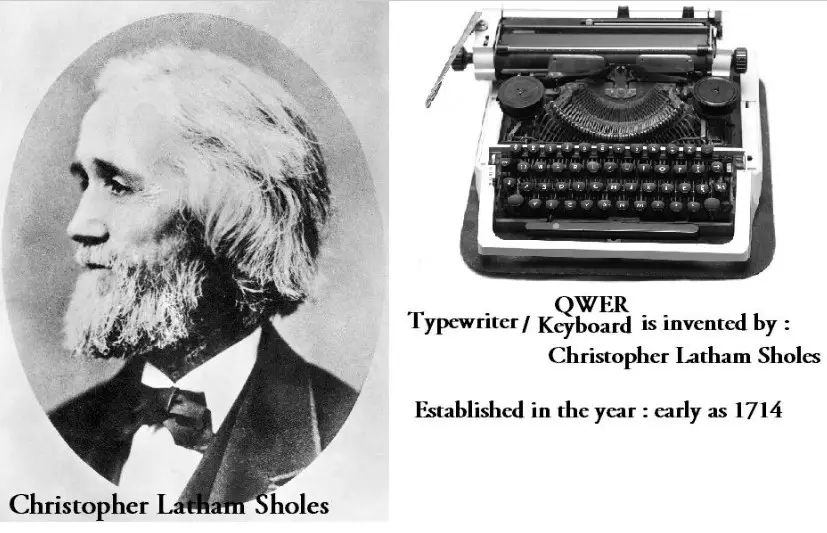Millions upon millions of individuals use keyboards on a regular basis. While typing, you may have pondered who invented keyboard layout.
The QWERTY keyboard layout is the de facto standard for electronic devices, whether it’s a gaming-specific physical keyboard or the touch-screen one found in today’s smartphones and tablets. If you’re curious in the origins of the modern keyboard layout, this article can fill you in.
Who Invented the Keyboard Layout
Christopher Latham Sholes, a mechanical engineer and newspaper editor from the United States, is the one who is credited with creating the layout for keyboards. Sholes was born on February 14, 1819 in Pennsylvania. He had an unquenchable curiosity and a strong desire to simplify and improve existing ways of communication.

In the month of November 1868, Christopher Latham Sholes and his three associates sent the very first typewriter, which had 28 keys, to the Porter’s Telegraph College in Chicago. In 1870, two years later, Matthias Schwalbach collaborated with Christopher Latham Sholes to design a 38-key typewriter.
This typewriter included specialized keys for the hyphen, comma, period, and question mark. The keyboard layout of these typewriters was not even remotely similar to the modern QWERTY layout, according to the written letters and patent applications that Scholes produced using these machines. The latter variant included four rows of keys organized in a manner that was virtually identical to alphabetical order.
The typewriter, which was invented by Sholes, completely changed the way written communication was done. Its influence was seen well beyond the world of journalism, reshaping fields such as administrative duties, publishing, and letter writing amongst other professions.
The layout of the keyboard, which included an ingenious arrangement of keys, was an essential factor in the widespread acceptance of typewriters and, later, computer keyboards.
How did the keyboard get its layout?
How, therefore, did Sholes arrive at the present random QWERTY arrangement from the more logical alphabetical layout? One prevalent theory is that the designer of the QWERTY keyboard layout did so to avoid a mechanical lock-up of the typewriter’s keys.
We need to study the inner workings of a typewriter before we can grasp this concept. A typewriter’s keys are spaced apart on a type-bar, and behind them are two inked strikers that resemble hammers. Thus, the striker of the keys on the same type bar would often get stuck with each other when a typist entered a word, leading to a mechanical lock-up of the typewriter. This occurred because the frequently used keys on the Bigram Frequency appeared one after another.
Bigram frequency usage (seen in the image below) is a statistical language identification method that highlights the most common letter combinations.

Therefore, in order to avoid the mechanical lock-up that can occur with typewriter keys, Sholes devised the notion of physically separating the letter combinations that are used the most frequently according to the Bigram Frequency use. Therefore, if this hypothesis is accurate, then the QWERTY layout is one of those layouts that put the keys for the most frequently encountered letter pairs such as “t h”, “i n”, “h e”, and others the farthest apart from each other.
Yet, historians are still unsure of how to explain a peculiar aspect of Sholes’ new layout. The “R” key was purportedly absent from the top row of the keyboard on early prototypes of Sholes’ typewriters. This was supposedly due to the fact that the “R” key was moved to a lower position. Therefore, we’re looking at a QWE.TY layout. You’re right, the period was where the ‘R’ key should have been.
Nevertheless, before seeking a patent for his novel keyboard layout, Sholes altered it to the present QWERTY keyboard layout by placing the “R” key near to the “E” key. This was done before Sholes changed the arrangement to the present QWERTY keyboard configuration. Given that the “er” letter combination now occupies the fourth spot on the Bigram Frequency index, it might be said that Sholes made an unconventional choice. As a result, the placement of the letter “R” adjacent to the letter “E” baffled a great number of historians.
Despite this, a patent application for the QWERTY layout was submitted, and over the course of time, it evolved into the standard keyboard layout.
What is the famous layout keyboard?
Alternate keyboard layouts have arisen throughout the course of time, with the purpose of addressing particular problems like as ergonomics, typing efficiency, and the requirements of various languages. Prominent instances are the Dvorak Simplified Keyboard, which places frequently used keys beneath the strongest fingers, & the Colemak layout, which aims to strike a compromise between QWERTY familiarity and better efficiency. Both of these keyboard layouts aim to make typing faster and more accurate.
However, despite the existence of other keyboard layouts, the QWERTY layout continues to be the one that is both the most often used and the most generally recognized globally. Its notoriety is due to the fact that it has already been created, that it is compatible with the infrastructure that is already in place, and that its users are already familiar with it, which makes it an enduring representation of Sholes’ inventiveness.
Final Words
You may have pondered on who invented keyboard layout at some point, whether it was out of simple inquisitiveness or a passion for learning the backstory of significant technological advances. This article goes into the fascinating life story of the individual who designed the keyboard layout. It sheds light on the inventor’s motives, the procedure of the invention, and the long-lasting advantages that have resulted from their ingenuity.

I am a regular user of computer keyboards. For using keyboard face different kinds of problems and also solve it very easily. I love sharing knowledge about keyboards.
